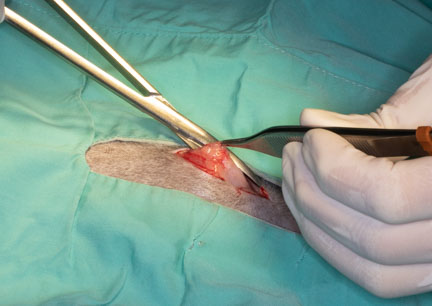Mr. Darcy was having symptoms of not feeling well and with blood in his urine, so his mom brought him to see Dr. Meredith Kennedy for a thorough exam.
During his exam, Dr. Kennedy palpated Mr. Darcy’s bladder, and noticed he was uncomfortable. As part of his routine diagnostic tests a radiograph was taken.
Mr. Darcy has not one, but two, stones in his bladder. Do you see them in this radiograph, just to the right of center?
If you can’t see them this view might help
It is not too often that Guinea Pigs get these stones. Bladder stones have several names. These include cystic calculi and urolithiasis. There are many different types of bladder stones, all with different causes. Our Bladder Stone page goes into this in more detail.
Graphic surgery pictures to follow.
Before surgery was performed we needed to make sure he is ready for surgery with a blood panel and medical treatment. Once we were sure he is ready for anesthesia we can begin the surgery to remove the stones. This surgery is called a cystotomy.
Mr. Darcy has had his tummy shaved, is connected to the anesthetic monitor, and has been scrubbed for his surgery
While Mr. Darcy is being prepared for surgery Dr. K is getting her sterile instruments ready
Our anesthetist closely monitors anesthesia, and only when he is stable, and at the proper level of anesthesia, does the surgery begins
After draping the first thing Dr. K does is infuse a long acting local anesthetic. This allows us to use less anesthesia during the procedure, and also allows Mr. Darcy to wake up pain free from his skin incision.
The skin incision is made just long enough to exteriorize the urinary bladder. Once through the skin Dr. K cuts through the subcutaneous (SQ) tissue to get down to the muscle layer
Mr. Darcy is 10 months old, and is being neutered at the same time, so that will also be done through this incision instead of through his scrotum. The less incisions the better for healing.
After the skin incision is made a scalpel is used to enter the abdomen by going through an area of the abdominal muscle where the tendons are located. This tendinous area causes minimal bleeding, and has better holding ability when the sutures are placed here at the end of the surgery. This will prevent a hernia.
The tendon incision at the abdominal muscles is extended to the proper length with a special surgical scissors
Once the abdomen has been entered Dr. K palpates the area to find the urinary bladder
Guinea Pigs have a large cecum (our appendix), that wants to come out through the abdominal incision. You can see the urinary bladder between Dr. K’s fingers on the right.
Once the intestines are put back where they belong (they want to keep coming out during the surgery) a special suture called a “stay” suture is put in the urinary bladder to keep it exteriorized and away from the intestines. In this picture Dr. K is using our laser to make the initial urinary bladder incision.
This bladder is inflamed and painful due to the stones irritation the lining. We use our carbon dioxide laser routinely on problems like this due to its tremendous ability to minimize bleeding during the surgery, and post operative pain and inflammation after the surgery. We have a page dedicated to laser surgery for more information.
As Dr. K continues to use the laser to enter the urinary bladder the stones become apparent
Once the urinary bladder is fully incised the stones are brought out with a hemostat
After the stones are removed the urinary bladder is carefully palpated to make sure there are no other stones or problems before being sutured closed.
A special suture material is used that is strong, will not inflame the bladder, and will dissolve slowly on its own over several months. This is an important part of the procedure, and the bladder is sutured carefully.
Dr. K neuters Mr. Darcy through the same incision. You can see the testicle in her hand as she is getting ready to remove it.
Our patients with skin incisions are given companion laser treatment before they are awakened from anesthesia. This laser allows for faster skin healing with less pain and inflammation.
Mr. Darcy is in good hands just after his surgery
We keep a close tab on him before he is put in recovery
Once in recovery he is closely monitored for temperature, breathing, pain, and bleeding
Mr. Darcy recovered rapidly and feels much better now that those stones are not irritation his urinary bladder. The next day he is checked carefully by Dr. K.
His incision looked great with no inflammation or sign of pain or infection. He was cleared to go home.
Mr. Darcy’s mom is happy he is feeling better
She sent Dr. K flowers as a token of her appreciation
You can learn more about how we do surgery in general on a wide variety of species at the Long Beach Animal Hospital from this link.
Return to the Guinea Pig Diseases page


























